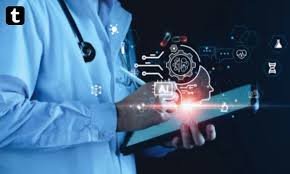The medical technology sector is undergoing a transformation fueled by advancements in science, AI, and data analytics. Innovations like wearable devices and AI diagnostics are improving outcomes, cutting costs, and personalizing treatments. This article explores key trends shaping the future of healthcare.
Artificial Intelligence in Healthcare
Artificial intelligence (AI) is rapidly transforming healthcare, making it one of the most impactful trends in medical technology. AI-powered tools are now being utilized to analyze complex medical data, identify patterns, and improve decision-making processes for both physicians and patients.
- AI for Diagnosis
One of the most impressive applications of AI is its capability for early and accurate diagnosis. Machine learning algorithms can evaluate imaging data, like MRIs and CT scans, with remarkable accuracy. For instance, AI tools are already being used to detect early-stage cancers, diabetic retinopathy, and heart disease. In fields like urology, EHR systems integrated with AI can further enhance diagnostic precision by streamlining patient data and identifying critical patterns. By assisting doctors with diagnoses, these technologies promise to speed up treatment and increase accuracy.
- Personalized Medicine
AI excels at analyzing vast amounts of patient data, enabling personalized medicine to thrive. Using genetic, lifestyle, and clinical data, AI algorithms can recommend tailored treatment plans that are uniquely suited to the individual patient, improving both outcomes and patient satisfaction.
Telemedicine and Remote Care
The COVID-19 pandemic accelerated the adoption of telemedicine, but its lasting impact on healthcare is undeniable. With more patients seeking care outside of traditional clinical settings, telemedicine has emerged as a vital tool for the future of medical technology.
- Remote Monitoring with Wearables
Smart wearable devices like fitness trackers and smartwatches are no longer just about counting steps. These devices now monitor heart rates, oxygen levels, sleep patterns, and even atrial fibrillation. Coupled with telehealth platforms, this data enables doctors to monitor patients remotely and intervene earlier when necessary.
- Virtual Consultations
Telehealth platforms allow patients to have real-time consultations with doctors, psychologists, or physical therapists from the comfort of their own homes. Beyond convenience, these services play an essential role in providing access to healthcare for individuals in underserved or remote areas.
Robotics in Healthcare
Healthcare robotics is gaining momentum, ushering in innovations that improve surgical precision, rehabilitation, and patient support.
- Surgical Robotics
Robotic surgical systems, like the da Vinci Surgical System, are helping surgeons perform minimally invasive procedures with greater accuracy and control. These systems enable smaller incisions, reduced recovery times, and better outcomes for patients.
- Rehabilitation Robots
Robotic systems are also being used in physical therapy and rehabilitation. Exoskeletons, for example, are giving paralyzed patients the ability to walk again and helping stroke survivors regain mobility faster.
Genomics and Gene Editing
Advances in genomics and gene-editing technologies, such as CRISPR-Cas9, are revolutionizing the way we approach genetic disorders and inherited diseases.
- Gene Editing for Therapies
Gene editing holds the promise to cure conditions that were once thought to be untreatable, like cystic fibrosis, sickle cell anemia, and certain forms of cancer. By targeting and modifying specific genes, these therapies have the potential to bring about radical improvements in patient health.
- Precision Medicine
The field of genomics is fueling the rise of precision medicine. By understanding an individual’s genetic makeup, healthcare providers can predict disease risk and tailor preventive measures and treatments to the specific needs of each patient.
3D Printing in Medicine
3D printing, also known as additive manufacturing, is reshaping the medical field in profound ways.
- Customized Prosthetics and Implants
With 3D printing, healthcare providers can create customized prosthetics, dental implants, and surgical tools tailored to fit each patient’s anatomy perfectly. This reduces costs and improves patient comfort and outcomes.
- Bioprinting Organs
While still in its early stages, bioprinting has made significant progress in creating viable organ and tissue samples for research and transplantation. The potential to eliminate organ donation waiting lists entirely is a future prospect that excites the medical community.
Blockchain for Healthcare
Blockchain, most commonly associated with cryptocurrency, is finding its footing in healthcare as well. Its ability to securely store and share data makes it an emerging trend with enormous potential.
- Data Security and Privacy
The decentralized and encrypted nature of blockchain offers a secure way to store sensitive healthcare information. Patients gain more control over their data while hospitals and healthcare organizations can reduce the risks of breaches.
- Streamlined Supply Chains
Blockchain technology is also being used to track medical supplies and pharmaceuticals, reducing inefficiencies and helping to prevent counterfeit products from entering the supply chain.
Sustainability and Green Innovations
An often overlooked but vital trend in medical technology is the push for environmentally sustainable healthcare solutions.
- Energy-Efficient Devices
New energy-efficient medical devices and healthcare facilities are being designed to reduce carbon footprints, making the healthcare industry more sustainable.
- Biodegradable Materials
The incorporation of biodegradable materials in medical tools and equipment is reducing medical waste, which has been a longstanding environmental problem.
Conclusion
The trends shaping the future of medical technology are not only reshaping the healthcare ecosystem but are also providing hope to millions across the globe. From AI-powered diagnostics to sustainable medical innovations, these advancements hold the promise of more effective, accessible, and personalized care.
